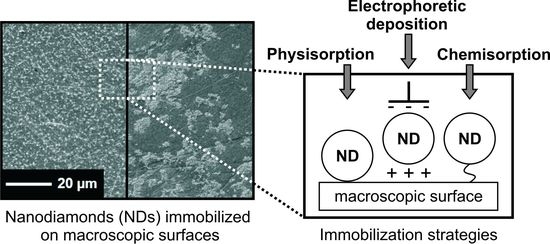Detonation nanodiamonds (NDs) are a novel class of carbon-based nanomaterials, and have received a great deal of attention in biomedical applications, due to their high biocompatibility, facile surface functionalization, and commercialized synthetic fabrication. We were able to transfer the NDs from large-size agglomerate suspensions to homogenous coatings. ND suspensions have been used in various techniques to coat on commercially available substrates of pure Ti and Si. Scanning electron microscopy (SEM) imaging and nanoindentation show that the densest and strongest coating of NDs was generated when using 1-ethyl-3-(3-dimethylaminopropyl)carbodiimide and N-hydroxysuccinimide (EDC/NHS)-mediated coupling to macroscopic silanized surfaces. In the next step, the feasibility of DNA-mediated coupling of NDs on macroscopic surfaces is discussed using fluorescent microscopy and additional particle size distribution, as well as zeta potential measurements. This work compares different ND coating strategies and describes the straightforward technique of grafting single-stranded DNA onto carboxylated NDs via thioester bridges.

Detonation nanodiamonds (NDs) are a novel class of carbon-based nanomaterials, and have received a great deal of attention in biomedical applications, due to their high biocompatibility, facile surface functionalization, and commercialized synthetic fabrication. We were able to transfer the NDs from large-size agglomerate suspensions to homogenous coatings. ND suspensions have been used in various techniques to coat on commercially available substrates of pure Ti and Si. Scanning electron microscopy (SEM) imaging and nanoindentation show that the densest and strongest coating of NDs was generated when using 1-ethyl-3-(3-dimethylaminopropyl)carbodiimide and N-hydroxysuccinimide (EDC/NHS)-mediated coupling to macroscopic silanized surfaces. In the next step, the feasibility of DNA-mediated coupling of NDs on macroscopic surfaces is discussed using fluorescent microscopy and additional particle size distribution, as well as zeta potential measurements. This work compares different ND coating strategies and describes the straightforward technique of grafting single-stranded DNA onto carboxylated NDs via thioester bridges.
